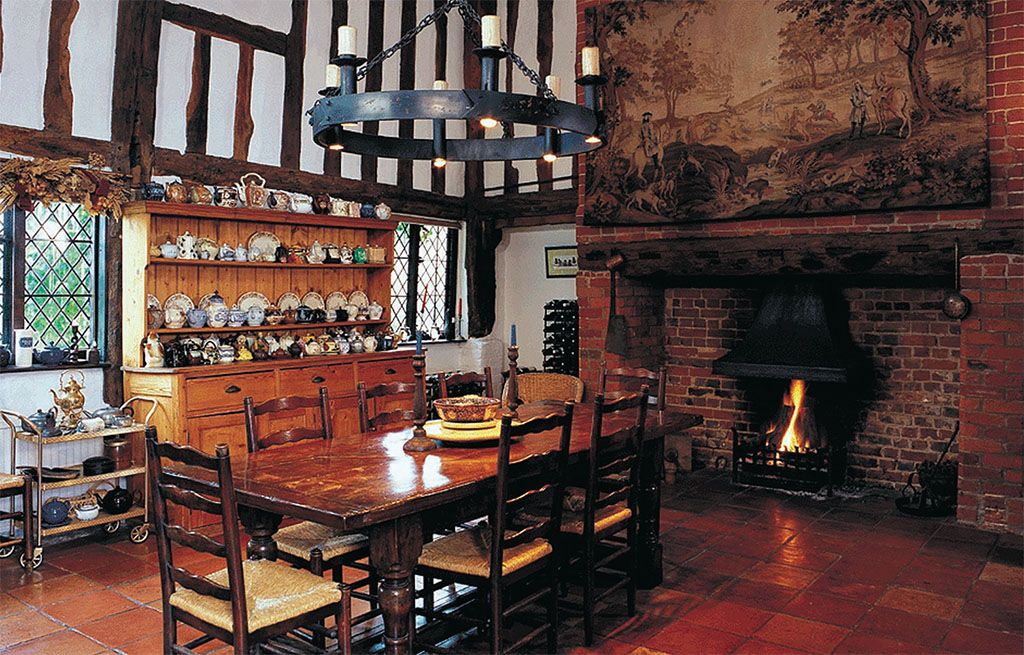
The Parlour shares the ground floor of the manor’s oldest wing with the Great Hall.
Here in the early 16th-century moated manor house, dreams of a permanent English colony in America took shape, and the Virginia Company was born.
There has been a manor at Otley since at least the time of the Domesday Book, and the place name itself is Anglo-Saxon. Deep in the lush Suffolk countryside, the site of Otley Hall has been occupied since the 12th century, when the de Otteleys were lords of the manor. From 1401 the Gosnold family first tenanted and then owned the manor of Otley and held large tracts of neighboring villages. Here in the early 16th-century moated manor house, dreams of a permanent English colony in America took shape, and the Virginia Company was born.
Today, Otley Hall belongs to Ian and Catherine Beaumont, who are delighted to be the conservators of the historic Grade I listed house for another generation. Ian was pleased to show me about the manor and its acclaimed gardens and share the stories of its past. The T-shaped semi-moated manor is a comfortable 10-bedroom house. Despite its age and architecture, it remains a lively family home to the Beaumonts and their young kids, Alexandra and Jasper.
“The house is renowned for staying pretty much intact, which is great news for us,” Beaumont enthuses. After Colonel Robert Gosnold VI backed King Charles I in the Civil War, the £600 fine levied against him by Parliament impoverished the estate. His son had to sell off the manor.
“After the Gosnolds left in 1674, the house was let to tenant farmers for more than 200 years,” says Beaumont. “They didn’t remove anything or maintain anything, so the place settled in and remained untouched.” In fact, Otley Hall is regarded as the oldest house in Suffolk to have survived the centuries largely unaltered.
During our tour, Ian showed me original Tudor wall nails, diamond-etched graffiti on 16th-century window glass, a spyhole made during the Civil War and wall paintings of the Gosnold coat of arms commissioned for a family wedding in 1559.
To the untrained eye, Otley Hall looks seamlessly o-l-d. In fact, the house grew in several building phases over a century. Though the ground within Otley’s moat had been built on many times over the years, the oldest existing wings were rebuilt by Robert Gosnold I in 1512 and 1518. His grandson (and Bartholomew’s uncle) Robert III added the Plahouse Wing in 1588 with a multipurpose Banqueting Hall above a ground floor loggia, where grapevine pargeting decorates the lintels.
As it happens, Gosnold’s cousin was Edward DeVere, the 17th Earl of Oxford. Oxford was famous in the theatrical world, and a patron of Shakespeare. The literary nobleman, in fact, has been sometimes championed to be the Bard of Avon himself. The young earl was often a guest for theatricals in Otley’s new “playhouse,” where traveling actors would put on plays for banqueting days.

The kitchen wing, built in 1518, is bright and airy, with a minstrel gallery that the Beaumont family uses as a music room.COURTESY OF OTLEY HALL, UK
“Yes,” Ian admits good-naturedly, “it’s often been suggested that Shakespeare may have visited here.” At the very least, Shakespeare’s connection with the family was close enough to explain his knowledge of Bartholomew’s 1602 voyage and the influence it may have played on The Tempest.
Like almost all medieval manors and stately homes, the house at Otley Hall grew up around the Great Hall, which now stands off-center in the original Gosnold wing. By contemporary standards, the Great Hall isn’t any bigger than a good-sized living room. It was here in the Great Hall that Bartholomew Gosnold held meetings through 1604-05 with Sir Thomas Smythe, Edward-Maria Wingfield, John Smith and others to advance plans for the Virginia Company expedition. Here Gosnold interviewed and recruited the 104 settlers and 55 crewmen who made the voyage to Jamestown. More than a third of them came from the villages immediately surrounding the manor of Otley.
Outside, the gardens surrounding the house are almost as impressive as the ancient manor itself. Though the vast landholdings of the Gosnolds have long been dispersed, Otley Hall still stands on the edge of Otley village in 10 acres of diverse and glorious gardens. An orchard, rose garden, croquet lawn, moated walk and nuttery blend a wild and cultivated landcape. And of course what Tudor garden would be complete without an authentic Elizabethan knot garden? The family’s pet peacocks have the run of the place.
The Independent placed Otley Hall sixth on its list of the 50 best British gardens to visit and rated it second among gardens with significant architecture.
There are three days a year when Otley Hall is open to the public, usually Summer Bank Holiday Sundays in May and August. The Beaumonts happily welcome a variety of group visits in all seasons. Training for the Anglican ministry, Catherine also hosts spiritually directed Quiet Days throughout the year, and the Gosnold Suite is often used for conferences, wedding receptions and private parties.
You can visit Otley Hall on its Web site at www.otleyhall.co.uk. Plan your own visit to Otley Hall by contacting Events Manager Kat Pennington at 01473 890264 or e-mail [email protected].
* Originally published in 2016.





Comments